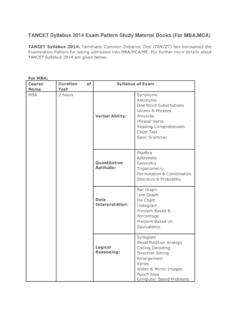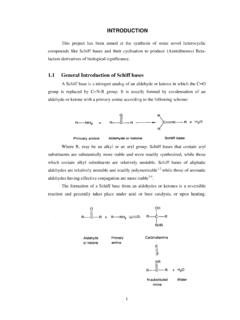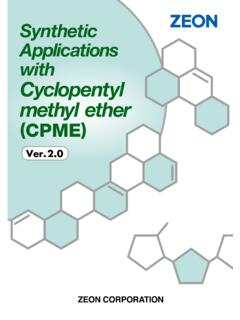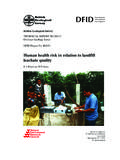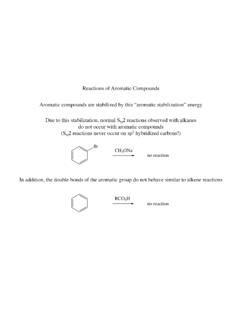Transcription of Explain the role of Eriochrome Black T and …
1 Code &Subject: CY2111&Engineering chemistry - I Dept. Name: chemistry Academic 2012-2013 St. Joseph s College of Engineering/Institute of Technology 1 ISO9001:2008 Unit I Water Technology PART A 1. Define Alkalinity. What are the ions responsible for the alkalinity of water?(June 2011) The acid neutralizing capacity is alkalinity. It is due to OH- , CO32- ions and HCO3- ions 2. Alkalinity of water cannot be due to the simultaneous presence of OH-, CO32- and HCO3.
2 Give reason. OH- and HCO3- ions react to form CO32- ions. OH- + HCO3- CO32- + H2O 3. What is hardness of water? What are its types? (Jan 2011, June 2012) The property of water not to lather with soap is called hardness. It is mainly because of hardness producing salts like MgCO3, CaSO4, Mg(HCO3)2 etc., Types - i) Temporary hardness ii) Permanent hardness 4. What are the disadvantages of using hard water in boiler? (Nov. 2010) Water used for steam generation should be free from hardness, otherwise it will cause boiler problems like scale and sludge formation, priming and foaming, boiler corrosion, etc.
3 Hence, water is softened before feeding it to boiler. 5. What are the salts responsible for the temporary and permanent hardness of water? Temporary hardness: Carbonates and bicarbonates of Ca and Mg (eg) CaCO3, Mg(HCO3)2. Permanent hardness: Sulphates, chlorides of Ca, Mg (eg)CaCl2, MgCl2, CaSO4, Mg SO4 6. How the hardness of water is expressed? What are the units practiced for expressing hardness of water? (Apr. 1995) (June 2009) The hardness is, usually, expressed in terms of equivalent amount of CaCO3.
4 The choice of CaCO3 in particular due to: a) Its molecular weight is 100 (equivalent weight = 50) which makes calculation easy. b) It is the most insoluble salt that can be precipitated in water treatment. Hardness can be expressed by any of the following units ppm - mg/L - degree Clarkes - Degree French 7. How is hardness of water detected? (Apr 1994) a) Eriochrome Black T indicator gives wine red colour in hard water. b)With soap, hard water gives a scummy precipitate. 2C17H35 COONa + CaCl2 (C17H35 COO)2Ca + 2 NaCl (Sodium stearate) (Scummy precipitate) 8.
5 Explain the role of Eriochrome Black T and ammonia buffer in the EDTA titration. (Dec 2011) (April 1995) Eriochrome Black T indicator is blue in colour. When EBT indicator is added to water sample, it forms a wine red coloured unstable Ca-Mg-EBT complex. This reaction is carried out under a basic PH of 8- 10 using ammonia buffer. Ca2+ / Mg2+ + EBT - [Ca / Mg EBT] (in water ) unstable wine red complex Code &Subject: CY2111&Engineering chemistry - I Dept. Name: chemistry Academic 2012-2013 St.
6 Joseph s College of Engineering/Institute of Technology 2 ISO9001:2008 When EDTA is titrated against the complex, EDTA replaces all the EBT and forms a stable Ca / Mg EDTA complex. The liberated EBT indicates the end point as steel blue. [Ca / Mg EBT] + EDTA [Ca / Mg EDTA] + EBT (Wine red/unstable) (Stable) (Steel blue) 9. What are ion-exchange resins? (May 2008); (May 2011) Resins are long chain, insoluble, cross linked, organic polymers.
7 There are 2 types. Cation exchange resins RH+ ( ) Sulphonated coals , RSO3H Anion exchange resins . R OH- ( ) Ureaformaldehyde, Amines R-NH2 10. Distinguish between soft water and demineralized water. (June 2011) S. No Soft water Demineralized water 1 It does not contain hardness producing calcium and magnesium ions, but it may contain other ions like K+, Na+, Cl- etc. Demineralized water does not contain any ions including hardness producing ions. 2 Softening involves removal of only hardness causing ions.
8 Demineralization involves removal of all the ions present in water. 11. What are Boiler troubles? How are they caused? (May 2007) Sludge and scale formation - Caustic embrittlement - Boiler corrosion - Priming and foaming are collectively known as boiler troubles. They are caused by the hardness causig salts present in boiler feed water. 12. What is caustic embrittlement? How it can be prevented? (June 2012) It is the inter crystalline cracking of boiler due to NaOH. NaOH content is increased due to the dissolved salts like Na2CO3 which is added during internal treatment.
9 To Prevent caustic embrittlement: i.) As softening agent, we can use sodium phosphate instead of sodium carbonate. ii) The hair line cracks can be sealed by waxy materials like Tannin and Lignin. 13. What are scales? How can it be prevented ? Mention its disadvantages.(June 2009) Scales are the Hard, thick , adherent precipitate on boilers Due to salts like CaSO4 , Ca(HCO3)2 present in water. Disadvantages: Wastage of fuel - Lowering of boiler safety - Decrease in efficiency - Danger of explosion Prevention methods: Internal treatment methods (eg) Calgon conditioning External treatment methods (eg) Ion exchange method By using mechanical scrubber 14.
10 What are priming and foaming? (Nov 2005) Priming: When boiler is producing steam rapidly, some particles of the liquid water are carried along-with steam. This process of wet steam formation is called priming. Foaming: It is the production of persistent foam or bubbles in boilers, which do not break easily. Code &Subject: CY2111&Engineering chemistry - I Dept. Name: chemistry Academic 2012-2013 St. Joseph s College of Engineering/Institute of Technology 3 ISO9001:2008 15.
